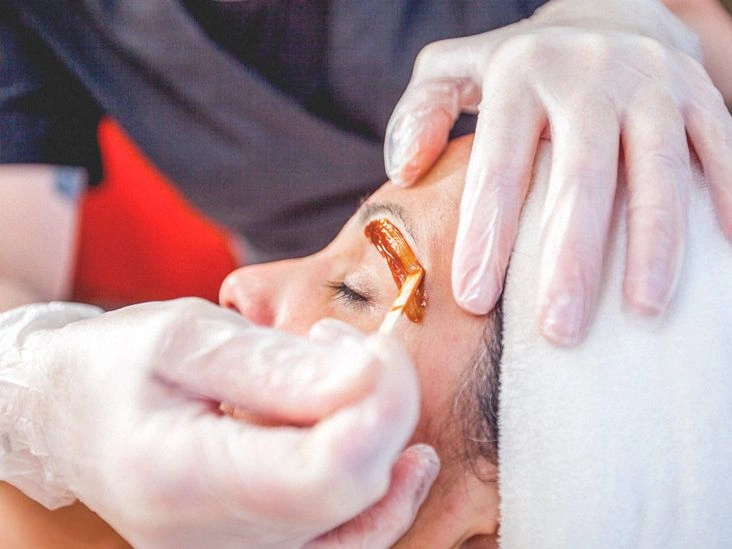Waxing is one of several hair removal methods beyond conventional shaving, tweezing, and chemical depilatories. It’s particularly suitable for facial areas when you want to remove larger patches of hair in one go.
Facial waxing uses either warm or cool wax that sets on the skin over unwanted hairs. The wax is then pulled away swiftly against the direction of hair growth, removing hair down to the root.
If you want longer-lasting smoothness, facial waxing may be an option to consider. That said, it’s important to be aware of potential side effects that can follow a face wax.

10 potential side effects of facial waxing
Face wax kits are commonly available at drugstores. However, that availability doesn’t guarantee they’re completely effective or risk-free. Below are 10 possible side effects of facial waxing and tips for managing them.
1. Pain
Some degree of discomfort is unavoidable with any waxing. The sensation comes from quickly removing strips adhered to the wax—similar to ripping off a tight adhesive from hairy skin. How much it hurts depends on your skin sensitivity, pain tolerance, hair density, and which parts of the face are treated. For instance, the upper lip may be more tender than the chin.
2. Redness and irritation
Waxing the face can cause temporary redness and mild irritation after the treatment. Newly waxed skin can appear pink or red and feel a bit tender. Avoid alcohol-based toners and other harsh products right after waxing, as they may sting. Redness typically subsides by the following day; a cool compress can ease tenderness.
3. Rashes
While redness and irritation are usually short-lived, rashes can also occur. These may persist for a day or longer. If a rash becomes severe or spreads, stop using the product immediately.
4. Temporary bumps
Small bumps may appear after waxing, forming at the pore openings where hair and roots were removed. Applying a soothing cream or balm can help, but these bumps generally resolve on their own within a few hours.
5. Ingrown hairs
Although often linked to shaving, ingrown hairs can follow waxing too. The risk is lower when you pull strips in the opposite direction of hair growth. Ingrown hairs are more likely when the hair shaft breaks beneath the skin rather than being removed from the root.
6. Sun sensitivity
Avoid waxing over a fresh sunburn, and be cautious about sun exposure after waxing. The procedure can remove a thin layer of the epidermis along with the hair, making the skin more vulnerable to sunlight—similar to the effect of a chemical peel.
7. Allergic reactions
Because face wax formulations vary, allergic reactions are possible. Test a small area (about the size of a dime) on your arm and remove hair per the product instructions. If no rash appears within 24 hours, it’s likely safe for your face. Don’t use the wax if the test causes hives, itching, or a red rash.
8. Bleeding
Occasionally waxing can lead to slight bleeding, which is usually normal and related to tiny bits of epidermis coming away with the hair. Expect only a small amount of blood. If you have fragile or mature skin, opt for products labeled gentle or for sensitive skin. Persistent or heavy bleeding should be evaluated by a doctor.
9. Infection
In some instances, waxing can trigger an infection at sites where the skin was damaged or bled. Using wax over a fresh cut or open wound increases this risk. Seek medical attention if you notice swelling, increased pain, or oozing at the treated site.
10. Scarring
Although uncommon, scarring can occur after facial waxing. The chance of scarring rises if wax is applied over cuts, if you get sunburned soon after waxing, or if an infection develops.
How to reduce the risk of side effects
There are several ways to minimize the side effects associated with face waxing. Mild pain and brief irritation are to be expected for at least the first few minutes, but other complications—such as ingrown hairs and bleeding—can be reduced.
Follow product directions closely, and ensure the wax is formulated specifically for facial use; avoid using body wax on your face. Also skip waxing if your skin is excessively dry, irritated, or sunburned.
Do not wax over active breakouts, open wounds, rashes, warts, or moles. People with circulatory conditions or diabetes should heed product warnings and consult a healthcare provider before waxing.
For optimal results and fewer complications, consider having facial waxing performed by a professional, such as a licensed medical esthetician. They can recommend the best approach for your skin type and use techniques that minimize adverse effects.


















Leave a Reply
You must be logged in to post a comment.